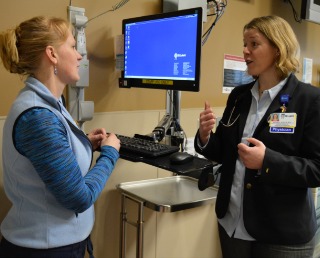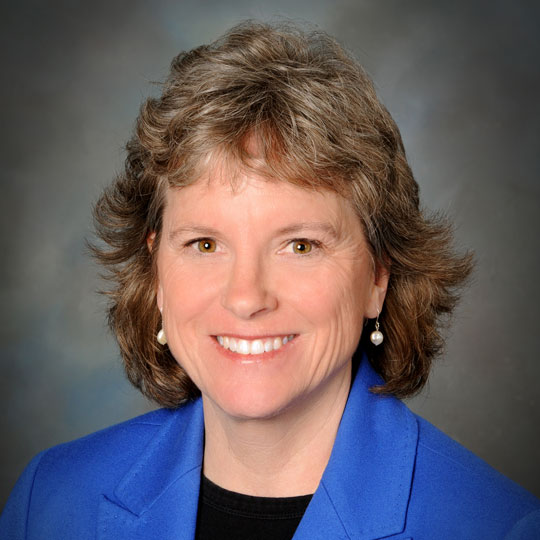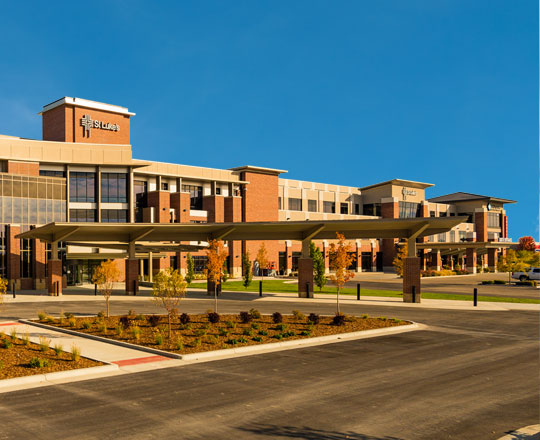Wiring St. Luke’s Nampa for Telehealth: ‘A picture is worth a thousand words’

If a patient arrives at the hospital with a drooping face, weak arm and slurred speech, Dr. Michaela Schulte instantly recognizes the symptoms of a stroke. And that she must act quickly.
“In these high stakes moments when you don’t have a lot of time to waste, it is so important. We know ‘time is brain,’ and we have to make a diagnosis and treatment decision as quickly as possible,” said Dr. Schulte, an internal medicine physician and hospitalist medical director at the new St. Luke’s hospital under construction in Nampa.
“Ideally, we want to start treatment within 60 minutes for a patient presenting symptoms of an acute stroke,” she said. “The diagnosis of a stroke and decision to treat, or not to treat, are complex and carry huge implications for the patient’s life.”
With telehealth technology being installed in the Nampa hospital, Dr. Schulte will be able to make decisions at the patient’s bedside in Canyon County while consulting directly with a neurologist in an offsite location.
“Having access to an expert opinion within a few minutes helps the patient to get the most appropriate care they need,” she said.
Telehealth is offered in the Nampa emergency room, and when the new hospital opens in October, telehealth services will expand with five patient beds in the telemetry unit and five to 10 ICU beds, as well as a mobile cart.
Using a camera, microphone and video monitor, specialists can observe a patient’s symptoms, consult with on-site providers and communicate with patients and families alike.
While the Nampa hospital will be wired throughout for telehealth, the initial primary clinical opportunities supported by the technology will be neurology services and critical care consultation as well as management in the ICU.
In her previous job at West Valley Medical Center in Caldwell, Dr. Schulte benefited from expertise delivered through ICU telehealth technology such as that provided by St. Luke’s.
“With the push of a red button, a specialist can ‘appear’ in the room, see the patient, review the medical records and help guide further work-up and treatment. It helped tremendously to expand the care for our sickest patients,” she said.
Krista Stadler, senior director of telehealth at St. Luke’s, said the technology helps ensure patients receive outstanding, convenient and cost-effective care.
“When a patient is admitted with a certain diagnosis, they may or may not need a specialist consult,” she said. “It is difficult to predict who will need this type of service and when. We have skilled providers and specialists throughout our health system who specialize in certain diseases and diagnosis.”
Telehealth allows those with specialized skills to be available to every patient, regardless of geographic location, Stadler said.
“A patient may come to the hospital with a gastrointestinal bleed but also suffer from a series of migraines and diabetes,” she said. The hospitalist leads the care team but may request a specialist for a consult to dive deeper into a certain area of the patient’s condition.
“Our goal is to provide multiple specialty services via telehealth. Utilizing the technology ensures the patient gets expert care close to home, regardless of where the provider resources may be located in a patient’s time of need,” Stadler said.
Stadler said that the technology better utilizes time for patients and providers.
“Rather than the provider spending time driving, they can see more patients and provide more immediate individualized care,” she said.
In the past, Stadler said providers relied primarily on phone calls without the visual data.
“What’s different between a phone and a video consult is the visual that helps you pick up on the nuances of a clinical condition.”
Dr. Schulte agreed.
“A picture is worth a thousand words. Calling a specialist on the phone and describing symptoms can be time-consuming and it does not fully capture the entire picture,” she said. “If a specialist can see a patient and review their medical record, they are able to make a determination much quicker and in a safer fashion.”
Dr. Schulte believes that telehealth is a worthwhile investment.
“We have very well-trained physicians who are doing a great job, but we are navigating a very broad spectrum of disease presentation and patients,” she said. “This technology allows us almost immediate access to experts in the field for very critical decisions.
“And it reassures me that we are able to provide the patient with access to the best care, regardless of the location.”About The Author

Amy Stahl formerly worked in the Communications and Marketing department at St. Luke's.


